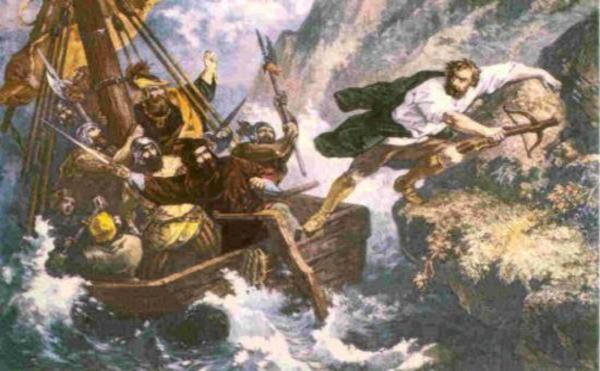
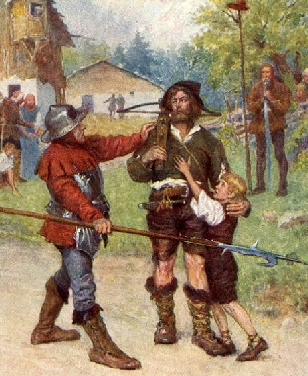
THE STORY OF THE LEGEND OF WILLIAM TELL
This link will focus on the legend of Wilhelm Tell in Swiss. And what do we see and hear of Wilhelm Tell nowadays?
Traces, stories, plays, opera, theater, paintings, old books, National trademark, locations, monument, museum and merchandise.
A brief resume
A Swiss legend about the apple of William Tell. The legendary Swiss crossbowman William Tell refused in 1307 to greet the hat that governor Gessler put on a stake in the village
square, as a symbol for the ruling Austria. Gessler then orders him to shoot an apple from the head of his son with his bow. He succeeds. However, when Tell is asked what the
purpose of his second arrow was, he replies that it was intended for the governor if he touched his son. He is captured on this. While Tell is taken to prison in a boat across
Lake Lucerne, a storm breaks out and he manages to escape. William Tell quickly returns to Küssnacht and shoots the governor with his crossbow.


The Swiss story
Long ago I read two books about Tell. There are some slightly different versions of the story.
On an autumn night in 1307 they came back to the Four Days Marches with a plaster to defend the celebration of the Austrian invaders. Men from three Swiss cantons on the Rütli meadow in
Unterwalden on the Vierwaldstättersee and promised to defend their country against the Austrian invaders with a solemn oath. The people of Switzerland were not always free and happy as they are today.
Many years ago a proud tyrant, whose name was Gessler, ruled over them, and made their lot a bitter one indeed. The cruel governor, Gessler, suspected trouble, and in order to gauge the plebiscite,
he set up a tall pole in the public square in Altdorf (in Crossbow Clermont), the capital of the canton of Uri, and put his own cap on the top of it; and then he gave orders that every man who came into the
town should bow down before it. They had to salute as if he were standing before the Habsburg Emperor himself. The Swiss swallowed their annoyance and obeyed. Until Wilhelm Tell, one of the 33 men
from Rütli, passed without showing any respect for the hat. He was seized by Gessler's men and taken to the governor. In Crossbow 1987 Tell avoid the square and his tempered son Matthew takes the hat
off the pole. (By the way: The son in the Swiss story is called Walter and Tell's wife is called in Crossbow Katrina and in the Swiss story his wife's name is Hedwig). He was afraid that other men
would disobey, and that soon the whole country would rebel against him. So he made up his mind to punish the bold man.
William Tell's home was among the mountains, and he was a famous hunter. No one in all the land could shoot with bow and arrow so well as he. Gessler knew this, and so he thought of a cruel plan
to make the hunter's own skill bring him to grief. Gessler (as Hermann Ricardo Neuhausen Gessler): "You, who can shoot like that," he said, "must do a master shot: you must shoot an apple from the head of your
child with an arrow." In vain, the upset father protested. Tell begged the tyrant not to have him make this test of his skill. What if the boy should move? What if the bowman's hand should tremble? What if the arrow
should not carry true? "Will you make me kill my boy?" he said. "Say no more," said Gessler. "You must hit the apple with your one arrow. If you fail, my soldiers shall kill the boy before your eyes." Gessler
would condemn both father and son to death. Then, without another word, Tell fitted the arrow to his bow. He took aim, and let it fly. The boy stood firm and still. He was not afraid, for he had all faith in his
father's skills. The arrow whistled through the air. It struck the apple fairly in the center, and carried it away. The people who saw it shouted with joy and Tell embraced his son. As Tell was turning away from
the place, an arrow which he had hidden under his coat dropped to the ground. "Fellow!" cried Gessler, " "You are a handsome shooter,"but tell me, why did you put a second arrow in your belt?" "Well," Tell
hesitated with his reply, but the governor said: "Say without fear the truth, I promise you that your life will be spared. Tell replied "then I will tell the whole truth. If I had hit my child with the arrow, then the other
one would have been for you, and he certainly would not have missed his purpose!"" was Tell's answer, "this arrow was for your heart if I had hurt my child." Because of the second arrow Gessler said: I will let
you go into the chains and take you to a place where neither sun nor moon shines."
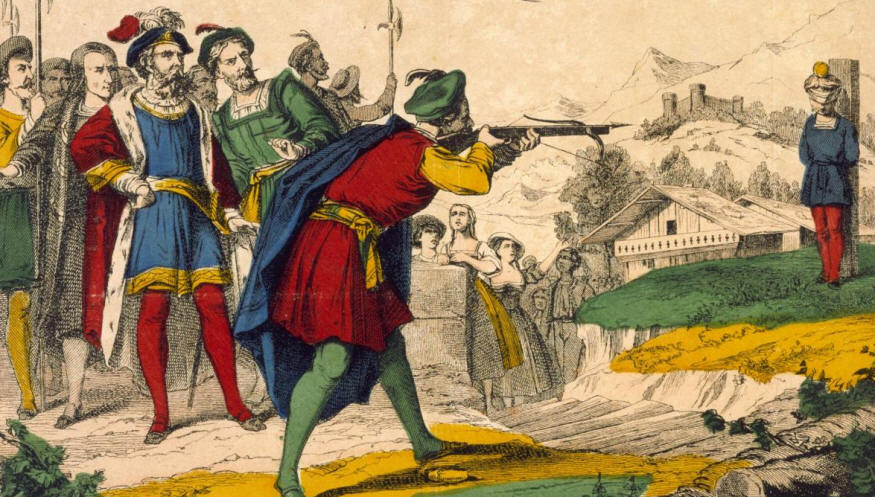
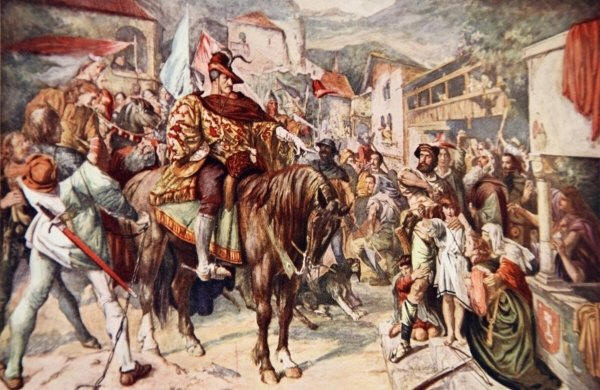

Then he ordered Tell to go to a castle on the other side of the Vierwaldstättersee. Hardly had the boat been put on shore, or a great storm broke loose. The ship was near the downfall. All on board cried
that Wilhelm Tell was the only one who could save them. Gessler released his fetters. As soon as Tell held the helm, he stopped right on the bank. When the boat slipped along a low plateau in the rock wall,
he took advantage of the opportunity, grabbed his bow and jumped on the rock, which is still called 'the Tellsplatte'. Before they understood what had happened on board, Tell had already disappeared
into the mountains. And there is an old story, that, not long after this, Tell did shoot the tyrant with one of his arrows; and thus he set his country free. Tell's leap (Tellensprung) from the boat of his
captors at the Axen cliffs; study by Ernst Stückelberg (1879) for his fresco at the Tellskapelle. Then Gessler drove to his palace the next day and he came to a hollow road between forest-covered heights,
an arrow whizzed on him and struck him in the chest. "That's Tells arrow," he said, "I know that." And then he died.
The traces of Wilhelm Tell in Switserland
The monument since 1895 (in Altdorf). Sculpted by Richard Kissling.
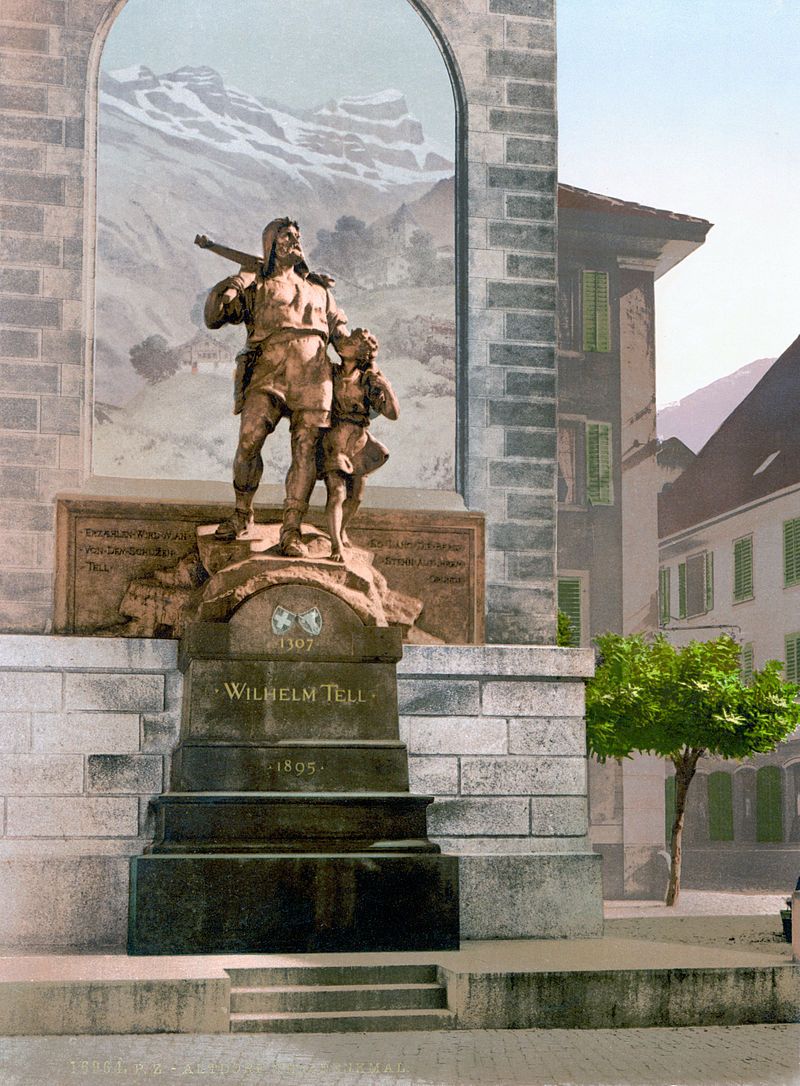
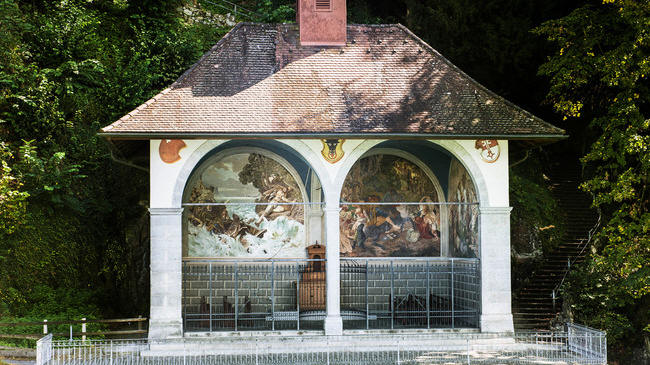
Local tradition says that a first chapel had been constructed in 1388 at the place where William Tell is said to have escaped from boat of the bailiff Gessler. The oldest documents mentioning a chapel
there date back to 1516/1530, however. The Tell chapel was built between 1879 and 1880. The chapel is located on the Tellsplatte on the right bank of the Lake Lucerne. Tell's chapel became a place of
pilgrimage from the 16th century on. The current chapel was constructed in 1879.
Four frescos by Ernst Stückelberger of Basle show the scenes of the legend: 1. The bailiff Gessler forces William Tell to shoot an apple off his son's head with his crossbow. 2.William Tell escapes from the
boat of the bailiff Gessler during a storm on Lake Lucerne. 3.William Tell shooting the tyrant Gessler. 4.The oath of the Swiss confederates on the Rütli. Below you can see the picture of the chapel at the lake.

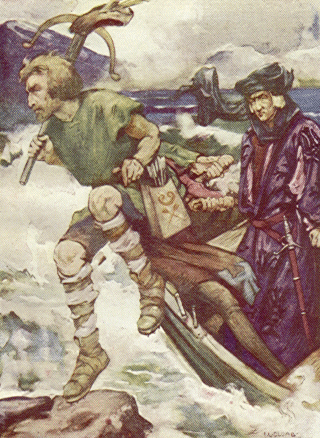
How to find Tell's Chapel: GPS coordinates lat=46.932719 lon=8.611801 Map by search.ch
The Hohle Gasse, (The hollow alley, Tell shot Gessler)
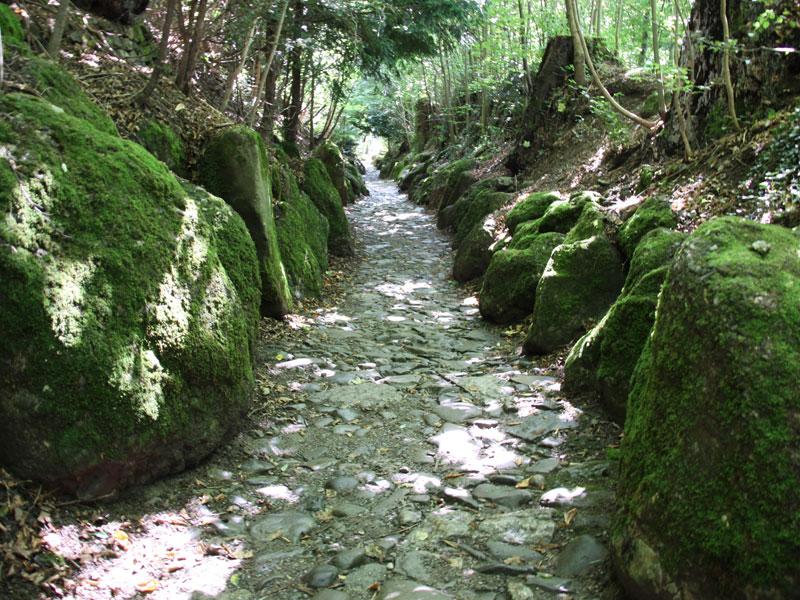
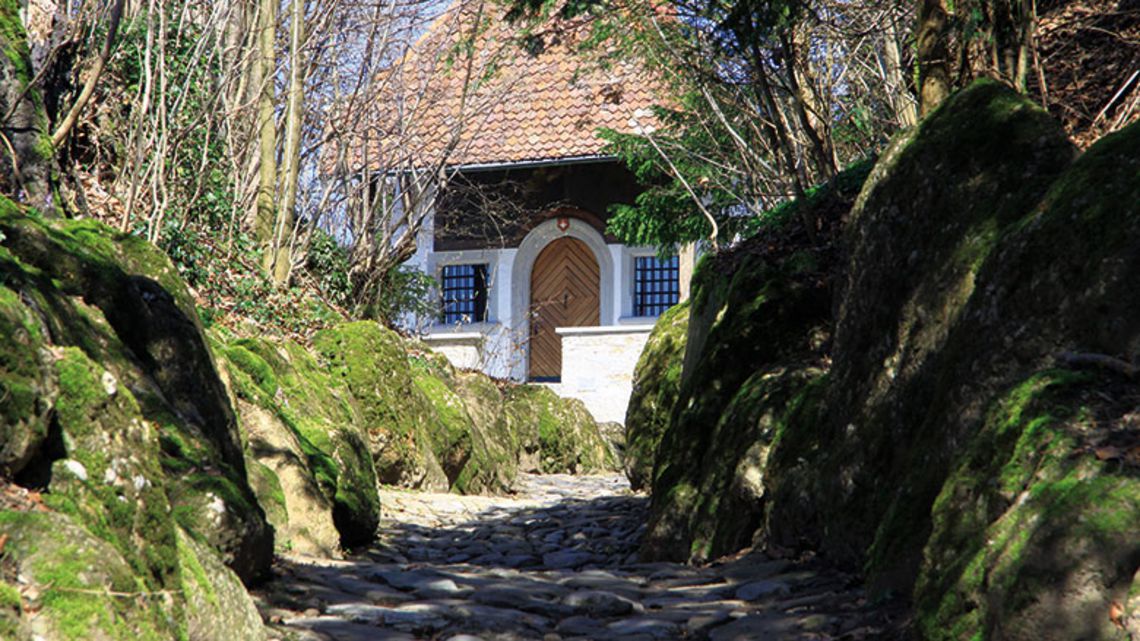
In the 'Holle Gasse.' Gessler's dead
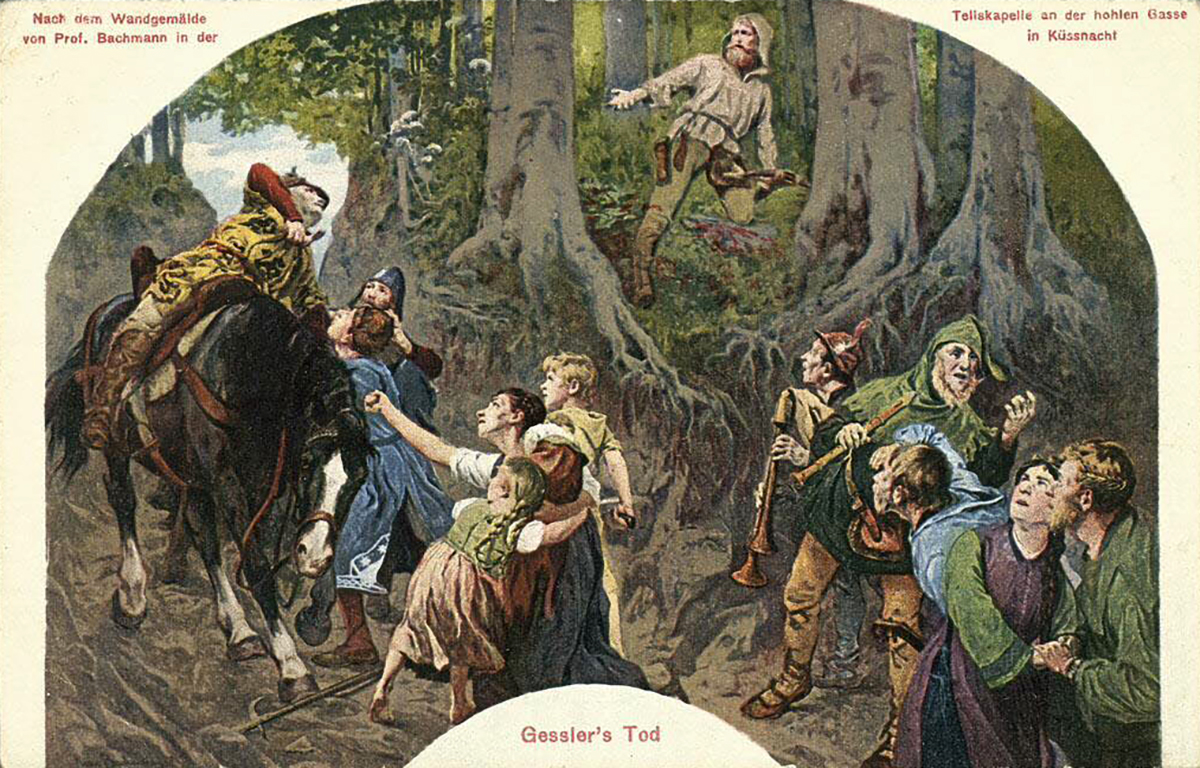
Painting of Tell's story in the chapel. An old postcard with all the paintings on it.
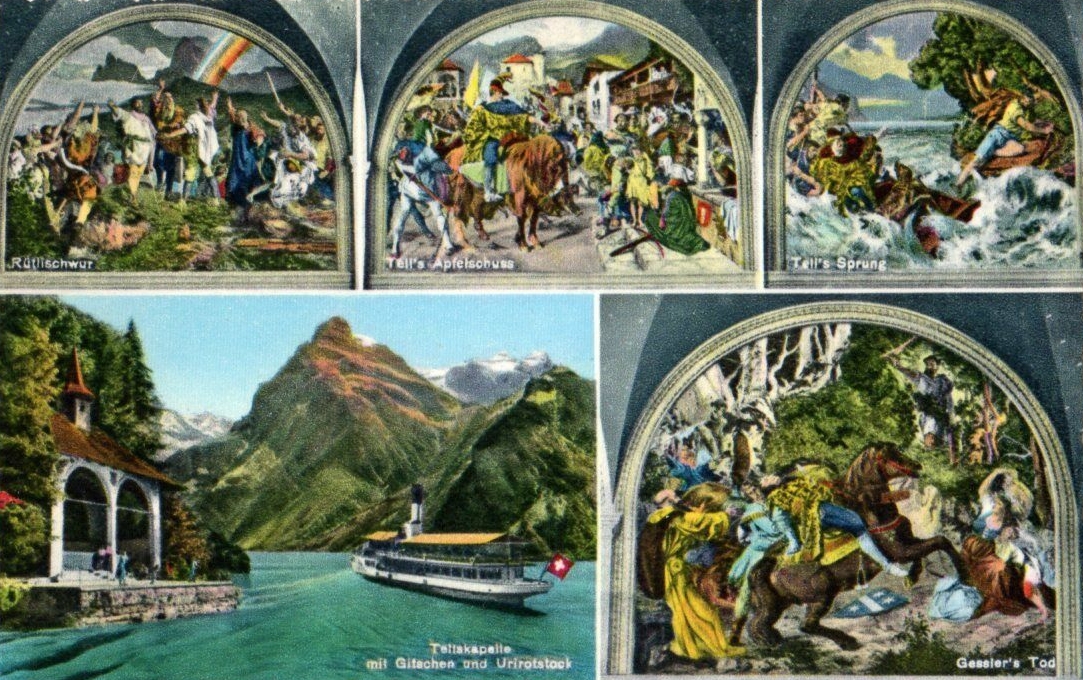
-First painting in tell's Chapelle The Rütlischwur is the legendary oath taken at the foundation of the Old Swiss Confederacy by the representatives of the three founding
cantons, Uri, Schwyz and Unterwalden, traditionally dated to 1291. It is named after the site of the oath taking, the Rütli, a meadow above Lake Uri near Seelisberg.
Recorded in Swiss historiography from the 15th century, the oath is notably featured in the play William Tell (Wilhelm Tell) by Friedrich Schiller (1804).
-The bailiff Gessler representing the count of Habsburg in central Switzerland requests that everybody greets his hat on a rod in Altdorf (Uri). William Tell refuses reverence to the hat. The bailiff
forces William Tell to shoot an apple off his sons head with his crossbow. William Tell hits the apple, but he has prepared a second arrow to shoot the bailiff in case he would have hurt the child.
The Jump of the boat
-William Tell is arrested and put in chains. The bailiff leaves with a boat on Lake Lucerne heading for his castle at Küssnacht. A storm due to warm fallwinds (not unusual in the region) brings the bailiff's team into
distress. They let William Tell, who is more familiar with the lake, control the boat. William Tell directs the boat towards a small flat rock, takes his crossbow and jumps off while pushing the boat back into the waves.
- Gessler's Tod/Gessler's death: William Tell shoots tyrant Gessler in the hollow way between Immensee and Küssnacht.
The tradition dates the heroic action of William Tell and the oath of the Swiss confederates against the counts of Habsburg on the Rütli back to 1307 (see above, date on monument). But one cannot find any document concerning a person named Wilhelm Tell nor the assassination of a bailiff in central Switzerland. Only in 1470, more than a century after the alledged events, a chronicle named the "White Book of Sarnen" reports the legend for the first time. A few years later, William Tell takes a prominent role in a ballad singing the praises of the beginnings of the Swiss Confederation. One generation later, a drama (Urner Tellspiel) is played in Central Switzerland. Centuries later, William Tell is mentioned in the standard history book Chronicon Helveticum (1734) by Aegidius Tschudi. In the 19th and 20th centuries the legend was severely questioned by historians.
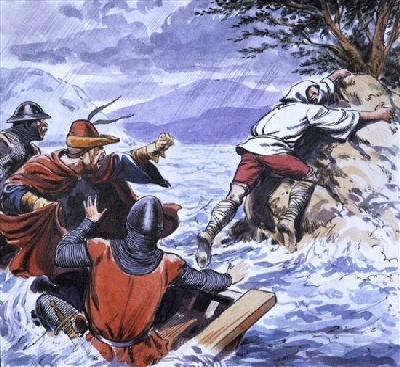
William Tell and the Revolution
William Tell was very popular during the French Revolution (1789) and he became the official symbol on the seal of the revolutionary Helvetic Republic of Switzerland
(1798 - 1803). Even the revolutionary Russians of the 19th century and the Spanish republicans of the 20th century referred to William Tell.
The classical drama Wilhelm Tell by the well-known German poet Friedrich von Schiller, put on the stage for the first time in 1804 at Weimar (home of Goethe and Schiller), is doubtless the most
elaborate and at the same time most popular version of the legend of William Tell. Schiller's drama is put on stage every year in Interlaken (www.tellspiele.ch) and even in New Glarus, Wisconsin, U.S.A.
(www.wilhelmtell.org). Friedrich von
Schiller was always very interested in the subject of liberty. His drama played
an important role for the German moral in the wars against Napoleon.
Before and during the second World War, William Tell became an important symbol of the Swiss will to withstand the Nazis and to defend Switzerland's autonomy against Hitler's ideas
of "Großdeutschland" (Great Germany uniting all German speaking regions in one empire). The reactivation of the Swiss tradition of liberation was part of the phenomenon called Spiritual
National Defense. Several films showed scenes from the legends in a naive manner as if there had never been any critical historian in the 19th century.
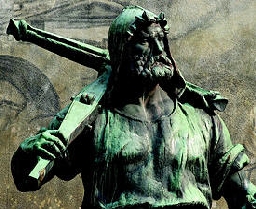
The usage of William Tell's crossbow as a label for Swiss quality products was also born in these times of crisis. In the 1970's, when the Spiritual Defense, extended during the cold war,was definitely
abandonded, the crossbow-label also disappeared quietly. Tell-Museum Bürglen, Postfach 127, Postplatz, 6463 Bürglen UR Gästebetreuung, Medien und Führungen, info@tellmuseum.ch T +41 41 870 41 55
The William Tell Opera by F. Schiller and G. Rossini
Guillaume Tell, the Opera based on F. Schiller's play. Part of this recognizable composition is still to hear during the end titles of the Crossbow movie 1987.
Guillaume Tell (or, in Italian: Guglielmo Tell) is an opera in four acts by Gioachino Rossini on a French libretto by Etienne de Jouy and Hippolyte Bis, based on Friedrich Schiller's play Wilhelm Tell, which in turn
is based on the legend from Willem Tell. It was performed for the first time at the Théâtre de l'Academie Royale de Musique on August 3, 1829. This opera was Rossini's last, although the composer lived almost
forty years after composing it. The length of the opera, roughly four hours of music, and the requirements imposed on the role, partly because of the high notes in the tenor part, have contributed to the difficulty
of carrying out the work. When it is executed, it is often heavily docked. Performances are given in both French and Italian. Other - political - reservations have contributed to the changing fortunes of the work.
In Italy the opera encountered difficulties with Italian censorship, as the work glorifies a revolutionary figure struggling against authority. The number of performances in Italy was therefore limited. The Teatro
San Carlo produced the opera in 1833, but gave no other performance for the next 50 years. The first performance in Venice, at the Teatro La Fenice, was not earlier than in 1856. In contrast, despite the censorship
problems, the Wiener Hofoper gave 422 performances in the years 1830-1907.
There are so many performances of William Tell opera's and theater performances in all kind of styles. Here made a small collection of some. You can find a lot via google.
William Tell opera in Palermo
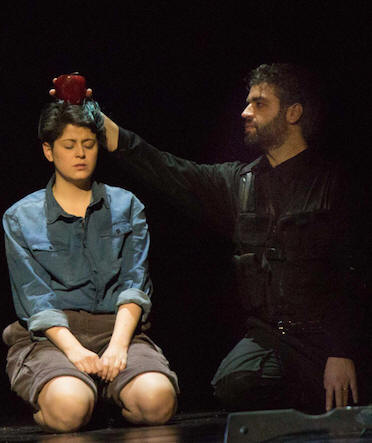
https://www.victorianopera.com.au/behind-the-scenes/william-tell-in-pictures
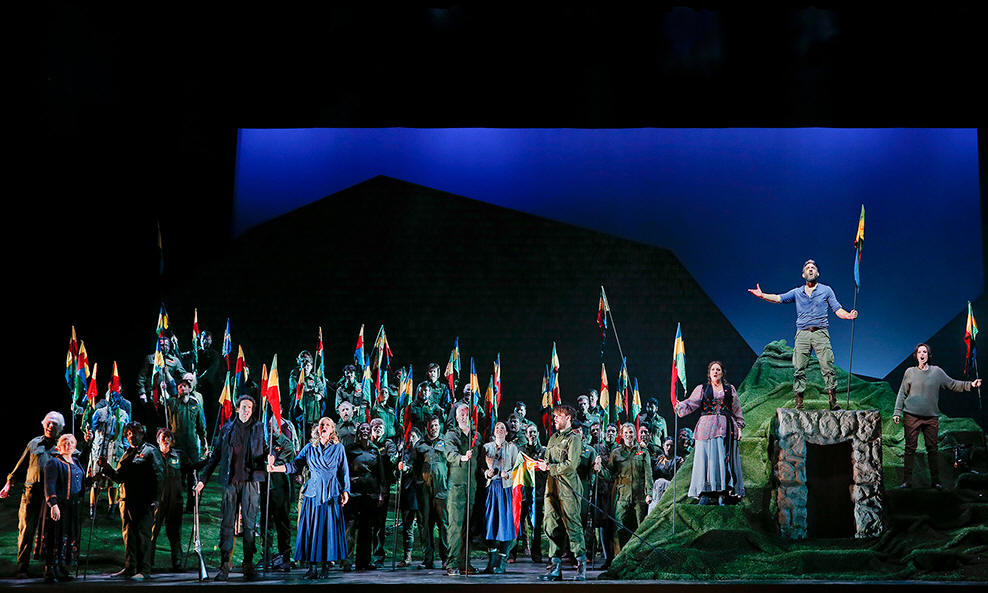
William Tell at the London opera House in 2015
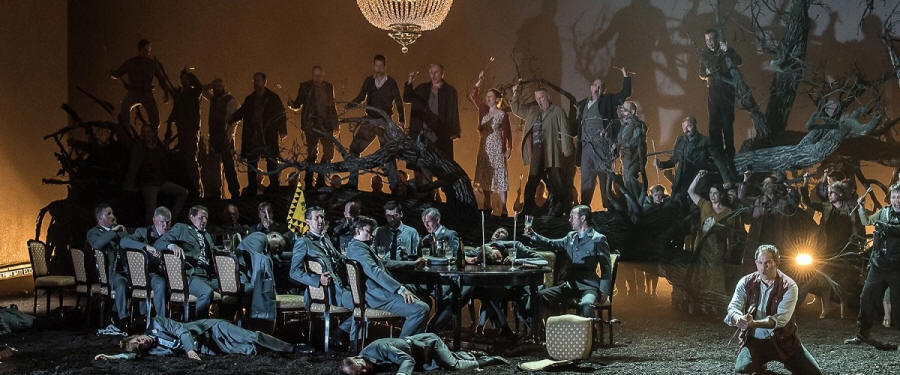
|
Saga, fact or fantasy? About Wilhem is furthermore only known that he would have fought in the battle of Morgarthen in 1315 and in 1354 would have drowned in the Alpenriviertje the Schächenbach when he tried to save a child. There is little evidence that Willem Tell really existed. The first mention of the legend dates back to 1569 in the Chronicum Helveticum by the Swiss historian Aegidius (or Gilg) Tschudi over the years 1000-1470. However, researchers have found that the Chronicum was based partly on carefully collected documents, but also on fantasy. The legend of William Tell was best known for the
eponymous play by Friedrich
Schiller from 1804 and the opera by Gioacchino Rossini from 1829. |
|
Finally The story of Willem Tell fits perfectly in the struggle for independence of Switzerland and its countrymen since 1291. Since that year, a number of Swiss states oppose the domination of the Habsburgs. Uri, where William Tell lived, belonged to this and became one of the three Catholic estates (with Schwyz and Unterwalden), who founded the Swiss Eedverbund on 1 August. No other Swiss person is so widely known as Wilhelm (William) Tell, the Swiss National Hero of Liberty - thanks to the German poet Friedrich von Schiller and his drama Wilhelm Tell. William Tell's picture can be seen on the back of coins worth 5 Swiss Francs (largest coin in Switzerland, approximately 4 US $) - but there is reasonable doubt whether Wilhelm Tell ever has lived at all. However, the very legend of William Tell itself did have an enormous influence on the history of Switzerland and of other countries. |
|
Personal touch Since I was a child I enclosed Will Lyman in my heart. I grew up with Will Lyman as William Tell. As a child he took me on many of the adventures and I became acquainted with freedom but also oppression and with the consequences of that in a country. The story of an ordinary man who has to defend his family and ultimately his country against a great force. In my opinion Will Lyman is the right actor for this role, who is convincingly calm, thoughtful and strongly reacts to the aggressors. Conrad as mentor is a nice addition to this series.
So we see the hero Wilhelm Tell of the previous series back in a nice role! Will Lyman is a stage veteran of over 40 years, having worked with multiple companies. He has been the narrator of the multi-award-winning PBS series FRONTLINE since 1984 His imdb is here His website is here.
When he speaks he sounds independent and credible. People like to hear his voice as a narrator. And so it is the same as his role in Crossbow. I regret I have not seen him in his role as King Lear in 2015.
And yes, I believe in legends like the story of William Tell and Robin Hood. I believe there must have been many simulair situations as well. And there have certainly been men who have been in almost the same situations but where no story has been written or told about. And if you watch how the Switsers champion shoots now crossbow then you know that it can really shoot an apple from a head. But stories such as Robin Hood (stealing from the rich and to give it to the poor) come from repression and injustice. I think that such situations can be of all times. See the uprising in France with the yellow vests (2018/2019). The enrichment of rich people in combination with non-compliance with election promises and politics, mismanagment, fraude and nepotism is a combination who could cause a lot of mistrust and trouble and the people with less money could be the victum. Sources of this link: Wikipedia, museum of William Tell, Jean François Bergier: Guillaume Tell. Paris: Librairie Arthème Fayard, 1988. More information on wikipedia: https://en.wikipedia.org/wiki/William_Tell |